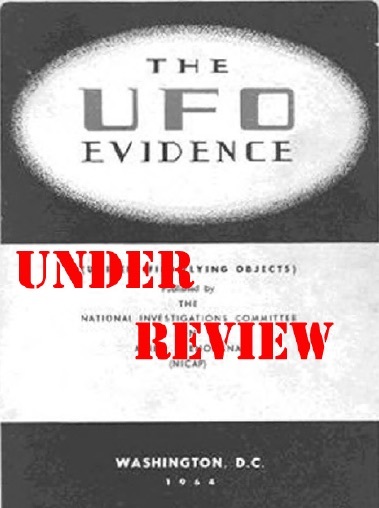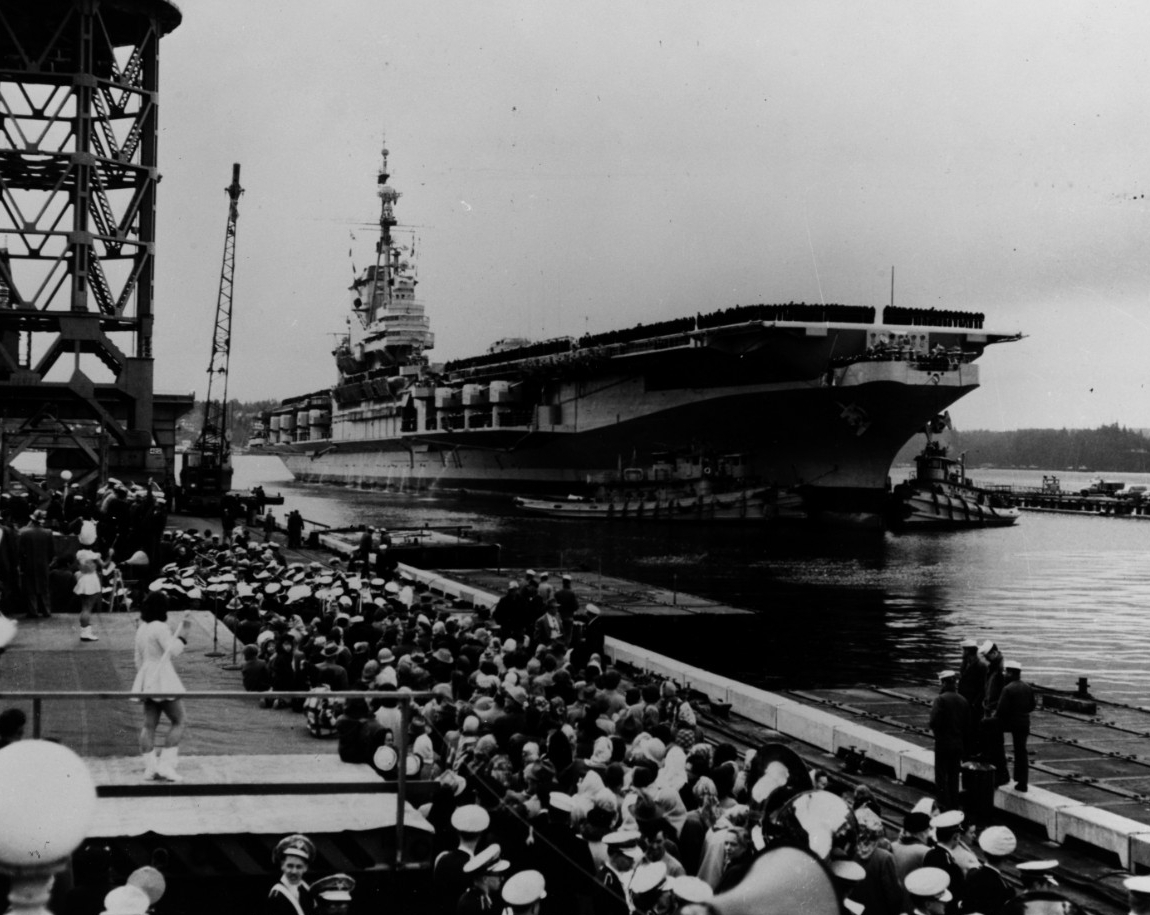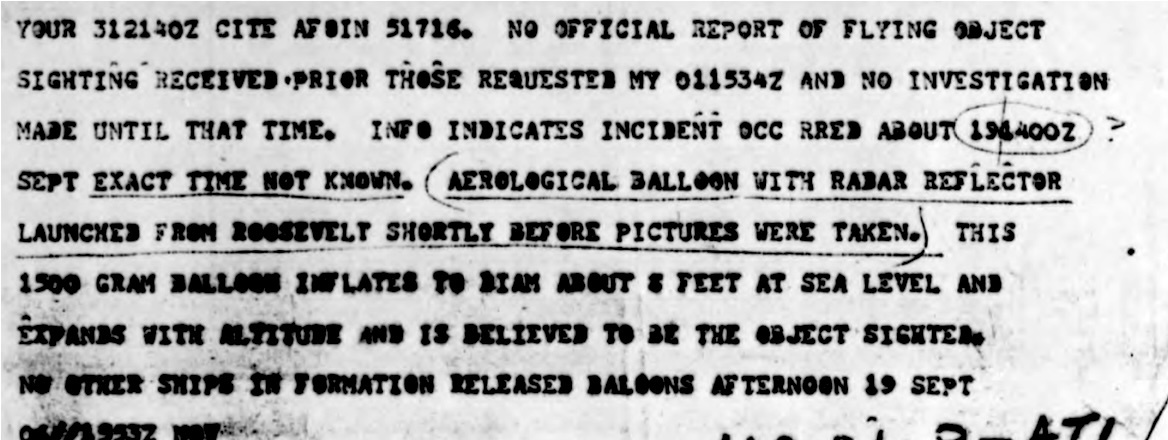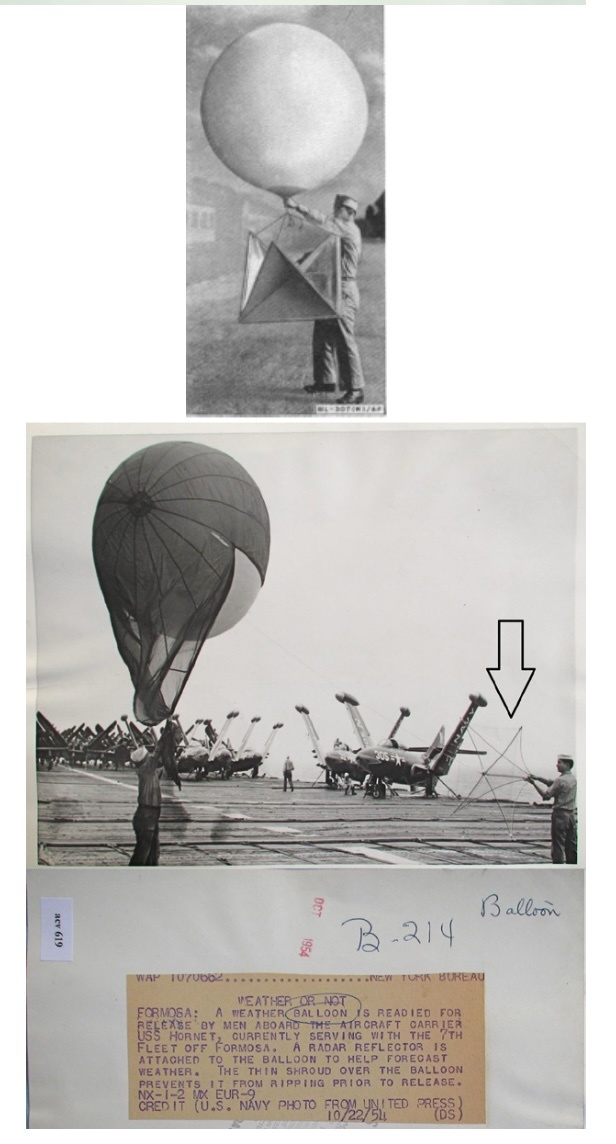14.02.2025

September 19, 1952 - North Sea
September 19, 1952--North Sea. Spherical UFO photographed from U. S. Navy aircraft carrier
participating in “Operation Mainbrace,” NATO maneuvers. [XII]

USS Franklin D. Roosevelt, NAVY
Section XII changes the date of this sighting to “about September 20”:
About September 20 - Personnel of the U.S. Aircraft Carrier Franklin D. Roosevelt, participating in the Mainbrace maneuvers, observed a silvery, spherical object which was also photographed.
(The pictures have never been made public). The UFO was seen moving across the sky behind the fleet. Reporter Wallace Litwin took a series of color photographs, which were examined by Navy Intelligence officers. The Air Force UFO project chief, Capt. Ruppelt stated: “[The pictures] turned out to be excellent ...judging by the size of the object in each successive photo, one could see that it was moving rapidly.” The possibility that a balloon had been launched from one of the ships was immediately checked out. No one had launched a balloon.[22] 2 Footnote 22 comes from Ruppelt’s book.
Details
Ruppelt’s account is as follows:
On September 20, a U.S. newspaper reporter aboard an aircraft carrier in the North Sea was photographing a carrier take-off in color when he happened to look back down the flight deck and saw a group of pilots and flight deck crew watching something in the sky. He went back to look and there was a silver sphere moving across the sky just behind the fleet of ships. The object appeared to be large, plenty large enough to show up in a photo, so the reporter shot several pictures. They were developed right away and turned out to be excellent. He had gotten the superstructure of the carrier in each one and, judging by the size of the object in each successive photo, one could see that it was moving rapidly.
The intelligence officers aboard the carrier studied the photos. The object looked like a balloon. From its size it was apparent that if it were a balloon, it would have been launched from one of the ships, so the word went out on the TBS radio: “Who launched a balloon?”
The answer came back on the TBS: “Nobody.”
Naval Intelligence double-checked, triple-checked and quadruple-checked every ship near the carrier but they could find no one who had launched the UFO.
We kept after the Navy. The pilots and the flight deck crew who saw the UFO had mixed feelings - some were sure that the UFO was a balloon while others were just as sure that it couldn’t have been. It was traveling too fast, and although it resembled a balloon in some ways it was far from being identical to the hundreds of balloons that the
crew had seen the aerologists launch.
Blue Book became aware of the event after the Photographer, Litwin, wrote them a letter on October 2nd. His account was:
“On September twentieth, at a few minutes after four p.m., I was standing on the forward flight deck of the USS Franklin D. Roosevelt, biggest carrier in the world. With me, at the time, was Lt. XXXXX (redacted), helicopter pilot. It was a bright day and there were occasional clouds in a very blue sky. As we were talking, I saw this round
object about five hundred or a thousand feet in the air, directly above the after end of this ship. I shouted something to XXXX (redacted) and ran aft a bit to shoot it with a bit of the ship’s ‘island’ in the picture to establish where. I had time to take a meter reading and three exposures before the rapidly rising thing was out of sight. The weather man man (sic) aboard sent a balloon up at three thirty and says it rose up and out of sight in the overcast in about fifty seconds. This was not it. The shots were in color...” Supposedly, there were three photographs taken but only one is
in the file.
Blue Book sent a message on October 3 requesting information about any balloon launches from any ship’s in the fleet. They also requested any information about another sighting on September 22 by an RAF bomber over Yorkshire. There is no indication that the Navy responded with any detailed information (they probably acknowledged the receipt of the message). As a result, the Air Force sent another message on October 14 requesting information about the investigation into any ship’s launching balloons. The reply by the Navy was that the RNAF was investigating other reported UFO sightings and that they were still investigating to see if there had been balloon releases. On November 6th, the Navy finally responded:

Ruppelt’s version indicates that there was a lot of checking and no balloon was launched. However, this indicates that, after checking, the Navy reported the event happened about 1400 on the 19th and a balloon had been launched with a radar reflector. There is also no indication that any crew members were ever interviewed contrary to what Ruppelt stated in his book.
Analysis
Looking at the photograph, it certainly looks like a balloon. This comparison shows the image on the right and a balloon in flight from 1944 on the left.6 The two look very similar. It is too bad the other images are not available to see if we can determine the balloon’s trajectory. I suspect their quality is low and one can only see a small object against the sky, if anything at all.

The Navy’s response to the USAF inquiry was delayed. This could have been due to several reasons. It takes time to check with all the ship’s in a fleet and it was a multi-national operation. Each ship involved had to look into their records to see if they launched any balloons.
Then the information had to be gathered by the fleet command and sifted to determine if they were possibly involved.
They also may have been in port at the time of the message. When in port, manpower is usually at a reduced level and contacting necessary personnel is not as easy as when they are on ship at sea. The final response by the Navy was the event happened on September 19th at 1400Z. Either the US Navy got the time and date wrong or Litwin did. We will never know because Blue Book did not ask about why the Navy said the date and time was different.

Missing in the photograph is the radar reflector that the navy stated was attached to the balloon. There can be reasons that it was not recorded. The first is that the photograph may not have the resolution to record the reflector or the reflector was not in an orientation that allowed it to be recorded. The 1955 version of Aerographer’s mate 3 and 2 says they were using the ML-307 and RR-32.7 Readers of SUNlite are quite familiar with the ML-307 (image
to upper right)8 but not the Suchy 4-corner reflector RR-32. I could not find a picture of one but I did find a photograph of a Navy balloon launch in 1954 that has a radar reflector (see arrow) that seems to match the description of one (a metalized nylon mesh supported by a lightweight metal framework).9 The radar reflector in the photograph is more transparent than the ML-307. If this was the kind of reflector being used, it might not have been visible in the photograph.
Another possibility is the reflector was never attached to the balloon. Just because the message says a reflector was attached does not mean that this was the case. The source of the information probably was the ship’s weather officer who did not supervise the balloon launches. These were done by enlisted men and did not usually have an officer
(or even a senior enlisted man) present. Balloon releases do not always have reflectors attached. The process described in Aerographer’s mate 3 and 2 requires that the ship’s radar be employed.10 This required some coordination between the balloon launching personnel and fire control radar director used for tracking. So, while reflectors were used, it was probably something that was not a frequent event. More than likely, they were used on overcast days where visual tracking was limited. The photograph shows the skies to be clear enough for visual tracking with theodolite, which implies there was no need for a reflector.
A final possibility is that the time and date the Navy listed was wrong, which means the photographer did not record the balloon with a reflector. This brings us back to square one with Litwin’s letter. Assuming that he gave the correct time and date, this means the Navy was checking the wrong date for balloon launches from the Roosevelt and other ships. According to wikipedia, there were 203 ships from nine different NATO countries involved in Mainbrace. Ten of these were aircraft carriers, which had their own compliments of Aerographer’s Mates and weather officers.11 There were also two battleships and six cruisers, which probably also had weather personnel. Considering the fact they got the date and time different than what Litwin reported, we don’t know how good the search for a balloon source was by the Navy.
In addition to the balloon issue, there is also the comments by Ruppelt where many navy personnel commented about what they saw. The case file makes no mention of these interviews. Like his comments that Naval Intelligence quadruple checked for a ship launching balloons and that no balloons had been launched, Ruppelt appears to have been exaggerating.
Conclusion
In my opinion, this is a case of “If it looks like a duck and acts like a duck...then it probably is a duck.” The object in the photograph looks a lot like a balloon and, based on Litwin’s account, it acted like one too. There were plenty of potential sources for this balloon and not just the USS Roosevelt. Ruppelt’s claim of a thorough search and that there were no balloon launches to produce the object in the photograph is not supported by the record. Based on the information we have, I classify this case as probably a balloon and it should be removed from the “best evidence” category.
Quelle: SUNlite 1/2025
